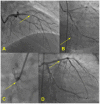Case Report: Hypertriglyceridemia and Premature Atherosclerosis in a Patient With Apolipoprotein E Gene ε 2 ε 1 Genotype
- PMID: 33537346
- PMCID: PMC7847930
- DOI: 10.3389/fcvm.2020.585779
Case Report: Hypertriglyceridemia and Premature Atherosclerosis in a Patient With Apolipoprotein E Gene ε 2 ε 1 Genotype
Abstract
We present a case of a 40-year-old male with premature atherosclerosis, with evidence of both eruptive and tendinous xanthomas, which could imply an increase in both low-density lipoprotein (LDL) and triglyceride (TG) levels. However, his LDL was 2.08 mmol/l, TG -11.8 mmol/l on rosuvastatin 20 mg. Genetic evaluation was performed using a custom panel consisting of 25 genes and 280 variants responsible for lipid metabolism. A rare ε2ε1 genotype of apolipoprotein E was detected. The combination of clinical manifestations and genetic factors in this patient leads to the diagnosis of familial dysbetalipoproteinemia. Implementation of genetic testing into routine clinical practice could not only improve disease diagnostics and management, but also help prevent their development.
Keywords: apolipoprotein E; familial dysbetalipoproteinemia; genetic testing; premature cardiovascular disease; triglyceride.
Copyright © 2021 Limonova, Ershova, Meshkov, Kiseleva, Divashuk, Kutsenko and Drapkina.
Conflict of interest statement
The authors declare that the research was conducted in the absence of any commercial or financial relationships that could be construed as a potential conflict of interest.
Figures


Similar articles
-
Severe xanthomatosis in heterozygous familial hypercholesterolemia.J Clin Lipidol. 2018 Jul-Aug;12(4):872-877. doi: 10.1016/j.jacl.2018.03.087. Epub 2018 Apr 3. J Clin Lipidol. 2018. PMID: 29778561
-
Severe Combined Dyslipidemia With a Complex Genetic Basis.J Investig Med High Impact Case Rep. 2019 Jan-Dec;7:2324709619877050. doi: 10.1177/2324709619877050. J Investig Med High Impact Case Rep. 2019. PMID: 31538826 Free PMC article.
-
[Hyperlipoproteinemia and dyslipidemia as rare diseases. Diagnostics and treatment].Vnitr Lek. 2016 Fall;62(11):887-894. Vnitr Lek. 2016. PMID: 28128575 Czech.
-
The molecular genetic basis and diagnosis of familial hypercholesterolemia in Denmark.Dan Med Bull. 2002 Nov;49(4):318-45. Dan Med Bull. 2002. PMID: 12553167 Review.
-
Familial dysbetalipoproteinemia: an underdiagnosed lipid disorder.Curr Opin Endocrinol Diabetes Obes. 2017 Apr;24(2):133-139. doi: 10.1097/MED.0000000000000316. Curr Opin Endocrinol Diabetes Obes. 2017. PMID: 28098593 Review.
Cited by
-
Spectrum and Prevalence of Rare APOE Variants and Their Association with Familial Dysbetalipoproteinemia.Int J Mol Sci. 2024 Nov 25;25(23):12651. doi: 10.3390/ijms252312651. Int J Mol Sci. 2024. PMID: 39684364 Free PMC article.
-
Apolipoprotein E Gene Polymorphism and Coronary Artery Disease Risk Among Patients in Northwest China.Pharmgenomics Pers Med. 2021 Dec 7;14:1591-1599. doi: 10.2147/PGPM.S338285. eCollection 2021. Pharmgenomics Pers Med. 2021. PMID: 34908864 Free PMC article.
-
Associations of APOE Gene Variants rs429358 and rs7412 with Parameters of the Blood Lipid Profile and the Risk of Myocardial Infarction and Death in a White Population of Western Siberia.Curr Issues Mol Biol. 2022 Apr 13;44(4):1713-1724. doi: 10.3390/cimb44040118. Curr Issues Mol Biol. 2022. PMID: 35723376 Free PMC article.
References
Publication types
LinkOut - more resources
Full Text Sources
Other Literature Sources
Miscellaneous

